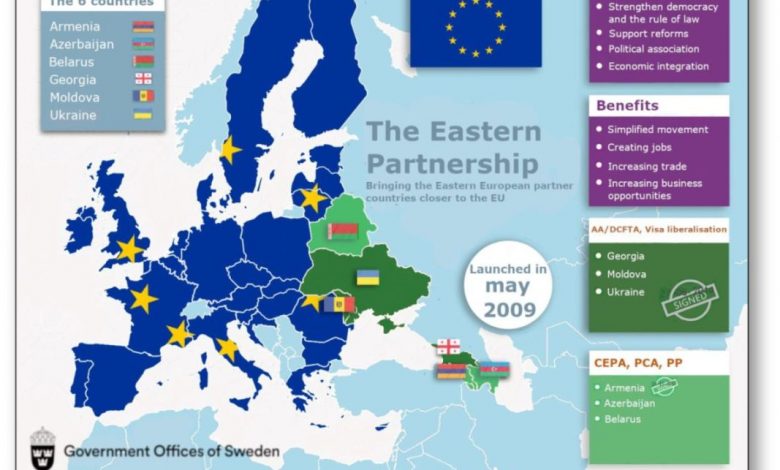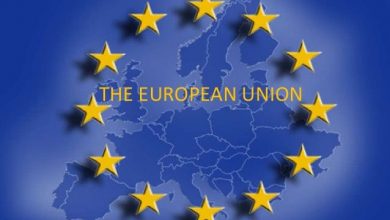EU accepts Eastern Partnership program
The European Union adopted the so-called Eastern Partnership program at the Brussels summit. It involves the establishment of special relations with some countries located on the territory of the former USSR. Among them, in addition to Ukraine, Georgia and the South Caucasus republics, Moldova. However, the proposal of the European Union did not cause much enthusiasm in Chisinau. Apparently, the local authorities are afraid to anger Russia, which plays an active role in Moldovan affairs, primarily in resolving the Transnistrian conflict.
Irina Severin: Eastern Partnership implies a closer level of cooperation between the countries participating in the program with the EU, including a facilitated visa regime and a free trade regime. However, those countries that declared their desire to gain full membership in the European Union, like Moldova and Ukraine, were rather skeptical about the new program. They fear that the Eastern Partnership could replace the prospect of EU membership. They are also unlikely to be inspired by the unified package approach of the EU towards them and those countries that have no prospect of membership in the European Union, which do not aspire to it.
Russia took the Eastern Partnership program negatively, seeing in it the expansion of the European Union and competition for spheres of influence in the common area for the EU and Russia. About what the difference between the Eastern Partnership program proposed by the European Union and the Neighborhood Policies effective since 2004 is, how the program is perceived in the context of the election campaign in Moldova, says Andrei Popov, Executive Director of the Moldova Foreign Policy Association.
Andrei Popov: The Eastern Partnership program is part of the old European Neighborhood Policy program through which the European Union pursues a more targeted policy. Previously, 16 countries, of which the majority on the southern flank in the Mediterranean and North Africa region coexisted with the countries of the Caucasus, Moldova and Belarus in the same program, with the current initiative, the European Union is narrowing its focus and distinguishing between countries that are neighbors of Europe, that is, which are not located on the European continent, and by countries that are European neighbors. 6 countries – the Caucasus plus Ukraine, Moldova, Belarus – are located on the European continent and can potentially become members of the European Union. Here is this program, which spells out a number of new instruments of interaction – such as the beginning of a dialogue on visa liberalization, an agreement on deep and comprehensive trade, as well as the possible conclusion of association agreements between the European Union and six Eastern Neighborhood countries.
Irina Severin: Does the Eastern Partnership policy involve financing real economic projects? How will this funding be provided?
Andrei Popov: In total, for the budget period until 2013, the new initiative involves 600 million euros for all six countries of the region. It is important not to lose sight of the cumulative effect of using all mechanisms of cooperation – the free trade regime, increasing stability and strengthening democratic institutions in six countries, which can help attract foreign investment. How will this money be distributed? Through targeted programs that are developed jointly by the governments of the member countries of the European Union, the European Union and the recipient countries of this assistance.
Irina Severin: Says Program Director of the Molodov Institute of Public Policy Oazu Nantoy.
Oazu Nantoi: As they say, tango dance together. The success of the programs offered by the European Union and the level of their financing depends on how open a particular country is for an honest partnership with the European Union, how capable it is of meeting the rules of the game that the European Union formulates. In this case, the European Union allocates a specific amount for the implementation of this program. This is a more serious program that provides for specific projects.
Irina Severin: President Voronin said in one of his interviews that the Eastern Partnership program proposed by the European Union reminds him of the ring around Russia, and expressed doubt whether Moldova should even take part in this initiative.
Andrei Popov: It is symbolic that the statement was made in the wake of Russian Foreign Minister Sergei Lavrov to Chisinau. It was of a opportunistic nature, with the main goal of preparing better ground for fruitful discussions in the “2 + 1” format and for promoting the Moldovan position. Russia perceives the Eastern Neighborhood program as directed against its interests in the zone between Russia and the European Union. And Voronin, in principle, said the same thing, that his perception of this program corresponds to the Russian one, that this ring is around Russia and, it seems, is not the result of the strategic choice of the Republic of Moldova against the Eastern Neighborhood program. I think Moldova will endorse it in the end. Just now there is a maneuvering. Moldova is trying to play between the European Union and Russia, relations between which are increasingly moving into the plane of competition, especially in the electoral context. But these statements, indeed, although I think they were addressed to an audience in Moscow, but they were carefully studied in Brussels as well. I think that such relations have seriously damaged the image of Moldova and the way the country is perceived by European partners.
Irina Severin: In your opinion, will the involvement of Transnistrian residents in the Eastern Partnership program of the European Union contribute to the resolution of the Transnistrian problem?
Andrei Popov: Although at this stage the mechanisms for involving such territories as Transdniestria are still substantive, I am not structured, but I observe the openness of the European Union in terms of involving Transnistria at different levels in the process of Europeanization. The European Union is not on the path of isolation, but on the path of soft attraction. Gradually, the export of Transnistria is reoriented to the European Union. At this stage, it exceeds the export of Transnistria in Russia.
Oazu Nantoi: After the armed conflict was stopped in 1992, there was a reorientation of interests and people on both banks of the Dniester. On the left bank and on the right bank, people switched to solving socio-economic problems, which were especially acute. Now it is quite obvious that there is no conflict between the population of the left and right banks. The EU’s policy of positively involving the region in common processes is quite effective.
Irina Severin: Moldova will present its official position on the Eastern Partnership program at the summit on the establishment of the initiative, which will be held on May 7.
This post is also available in:
 English
English  Русский (Russian)
Русский (Russian)






